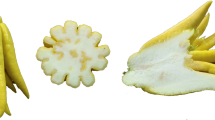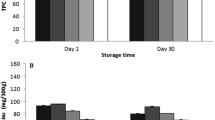Abstract
Natural antioxidants have gained interest for their role in preventing lipids oxidation. The goals of this investigation were to study the antioxidant potential of carrot (Daucus carota), grape (Vitis vinifera) leaf and turmeric (Curcuma longa) powder extracts and to evaluate their addition as natural antioxidants in biscuits. Physical and chemical properties of biscuit were evaluated during processing and storage. Electrophoretic properties of biscuit dough were carried out to understand the impact of different extracts on the processing of biscuits. Biscuits prepared with 1 % (w/w) grape leaves ethanol (70 %) extract (GLE), carrot aqueous extract (CE), and tumeric aqueous extract (TE) were acceptable. Among extracts, TE was found to retain only 11.2 % activity, wherein GLE had retained 51.0 % activity after baking, which was comparable to butylated hydroxyanisole and better than tert-butylhydroquinone (TBHQ). TBHQ was found to possess the highest activity, followed by GLE, TE and CE, respectively. The ash content of biscuits enriched with TE and GLE was near to that of the control sample. Addition of CE, GLE and TBHQ reduced the force required for breakage. After 15 days of storage, PV was increased in all samples, but in the case of GLE-enriched sample there was a sudden increase in PV from 0.034 to 0.374. Supportive electrophoresis study indicated that there was no change in the protein subunits of biscuit dough fro different samples. It could be concluded that GLE, CE and TE might be used in biscuit baking as natural antioxidants.


Similar content being viewed by others
References
D.L. Madhavi, S.S. Deshpande, D.K. Salunkhe, Food antioxidants (Marcel Dekker, New York, 1996)
M.F. Ramadan, Healthy blends of high linoleic sunflower oil with selected cold pressed oils: functionality, stability and antioxidative characteristics. Ind. Crops Prod. 43, 65–72 (2013)
M.F. Ramadan, M.M.S. Asker, M. Tadros, Antiradical and antimicrobial properties of cold-pressed black cumin and cumin oils. Eur. Food Res. Technol. 234, 833–844 (2012)
F. Liu, T.B. Ng, Antioxidative and free radical scavenging activities of selected medicinal herbs. Life Sci. 66, 725–737 (2000)
L.L. Yu, K.K. Zhou, J. Parry, Antioxidant properties of cold pressed black caraway, carrot, cranberry and hemp seed oils. Food Chem. 91, 723–729 (2005)
C.J. Dillard, J.B. German, Phytochemicals: nutraceuticals and human health. J. Sci. Food Agric. 80, 1744–1756 (2000)
J.A. Vinson, Y. Hao, X. Su, L. Zubik, Phenol antioxidant quantity and quality in foods: vegetables. J. Agric. Food Chem. 46, 3630–3634 (1998)
A.A. Adebowale, M.T. Adegoke, S.A. Sanni, M.O. Adegunwa, G.O. Fetuga, Functional properties and biscuit making potentials of sorghum-wheat flour composite. Am. J. Food Technol. 7, 372–379 (2012)
S.S. Mildner, W.N. Zawirska, W. Obuehowski, M. Goslinski, Evaluation of antioxidant activity of green tea extract and its effect on the biscuits lipid fraction oxidative stability. J. Sci. Food Agric. 89, 288–298 (2009)
H. Park, P.A. Seib, O.K. Chung, Stabilities of several forms of vitamin C during making and storing of pup-loaves of white pan bread. Cereal Chem. 71, 412–417 (1994)
M. Pokorny, P. Jan, Natural antioxidants for food use. Trends Food Sci. Technol. 2, 223–226 (1991)
H. Park, P.A. Seib, O.K. Chung, Fortifying bread with a mixture of wheat fiber and psyllium husk fiber plus three antioxidants. Cereal Chem. 74, 207–211 (1997)
G.S. Ranhotra, J.A. Gelroth, J. Langemeier, D.E. Rogers, Stability and contribution of beta carotene added to whole wheat bread and crackers. Cereal Chem. 72, 139–141 (1995)
S.S. Bassiouny, F.R. Hassanien, F.A.E. Ali, S.M. El-Kayati, Efficiency of antioxidants from natural sources in bakery products. Food Chem. 37, 297–305 (1990)
S. Bajaj, A. Urooj, P. Prabhasankar, Effect of incorporation of mint on texture, colour and sensory parameters of biscuits. Int. J. Food Prop. 9, 691–700 (2006)
M. Monagas, B. Hernandez-Ledesma, C. Gomez-Cordoves, B. Bartalome, Commercial dietary ingredients from Vitis vinifera L. leaves and grape skins: antioxidants and chemical characterization. J. Agric. Food. Chem. 54, 319–327 (2006)
Medical Economics, PDR for herbal medicines, 2nd edn. (Medical Economics, Montvale, 2002), pp. 362–363
L. Li, J. Zhong, Effect of grape procyanidins on the apoptosis and mitochondrial transmembrane potential of thymus cells. J. Hyg. Res. 33, 191–194 (2004)
L. Pari, A. Suresh, Effect of grape (Vitis vinifera L.) leaf extract on alcohol induced oxidative stress in rats. Food Chem. Toxicol. 46, 1627–1634 (2008)
J.D. Fan, H. Lou, W. Yu, D. Ren, B. Ma, H. Ji, Novel flavanol derivatives from grape seed. Tetrahedron Lett. 45, 3163–3166 (2004)
R.R. Dresch, M.K. Dresch, A.F. Guerreiro, R. Biegelmeyer, M.H. Holzschuh, D.F. Rambo, A.T. Henriques, Phenolic compounds from the leaves of Vitis labrusca and Vitis Vinifera L. as a source of waste byproducts: development and validation of LC method and antichemotactic activity. Food Anal. Methods 7, 527–539 (2014)
M. Sharma, P. Tripathi, V.P. Singh, Y.B. Tripathi, Hepatoprotective and toxicological evaluation of hepatomed, an ayurvedic drug. Indian J. Exp. Biol. 33, 34–37 (1995)
Y.B. Tripathi, S. Chaurasia, E. Tripathi, A. Upadhyay, G.P. Dubey, Bacopa monniera Linn. as an antioxidant: mechanism of action. Indian. J. Exp. Biol. 34, 523–526 (1996)
P. Chantaro, S. Devahastin, N. Chiewchan, Production of antioxidant high dietary fiber powder from carrot peels. Food Sci. Technol. 41, 1987–1994 (2008)
B. Hiranvarachat, S. Devahastin, Enhancement of microwave-assisted extraction via intermittent radiation: extraction of carotenoids from carrot peels. J. Food Eng. 126, 17–26 (2014)
Y. Dixit, A. Kar, Antioxidative activity of some vegetable peels determined in vitro by inducing liver lipid peroxidation. Food Res. Int. 42, 1351–1354 (2009)
B.N. Shyamala, P. Jamuna, Nutritional content and antioxidant properties of pulp waste from Daucus carota and Beta vulgaris. Malaysian J. Nutr. 16, 397–408 (2010)
K. Krishnaswamy, Traditional Indian spices and their health significance. Asia. Pac. J. Clin. Nutr. 17, 265–268 (2008)
V.B. Liju, K. Jeena, R. Kuttan, Acute and subchronic toxicity as well as mutagenic evaluation of essential oil from turmeric (Curcuma longa L). Food Chem. Toxicol. 53, 52–61 (2013)
S. Anubala, R. Sekar, K. Nagaiah, Development and validation of an analytical method for the separation and determination of major bioactive curcuminoids in Curcuma longa rhizomes and herbal products using non-aqueous capillary electrophoresis. Talanta 123, 10–17 (2014)
J. Park, J. Lee, W. Jun, Radical scavenging and anti-obesity effects of various extracts from turmeric (Curcuma longa L.). J. Korean Soc. Food Sci. Nutr. 24, 1908–1914 (2013)
S. Jin, J.-H. Hong, S.-H. Jung, K.-H. Cho, Turmeric and laurel aqueous extracts exhibit in vitro anti-atherosclerotic activity and in vivo hypolipidemic effects in a zebrafish model. J. Med. Food 14, 247–255 (2011)
AACC, Approved methods of the American Association of Cereal Chemists (AACC, St Paul, 2000)
P. Prieto, M. Pineda, M. Aguilar, Spectrophotometric quantitation of antioxidant capacity through the formation of a phosphomolybdenum complex: specific application to the determination of vitamin E. Anal. Biochem. 269, 337–341 (1999)
M. Sai, H. Rao, Effect of emulsifiers, fat level and type on the rheological characteristics of biscuit dough and quality of biscuits. J. Sci. Food Agric. 79, 1223–1231 (1999)
AOAC, Methods of analysis, 7th edn. (Association of Official Agricultural Chemistry, St Paul, 1986)
P. Prabhasankar, H.P. Rao, Effect of different milling methods on chemical composition of whole-wheat flour. Eur. Food Res. Technol. 213, 465–469 (2001)
Y. Pomrtanz, Wheat chemistry and technology (American Association of Cereal Chemists, St Paul, 1988)
B.R. Nanditha, B.S. Jenab, P. Pichan, Influence of natural antioxidants and their carry-through property in biscuit processing. J. Sci. Food Agric. 89, 288–298 (2009)
M. Lindenmeier, T. Hofmann, Influence of baking conditions and precursor supplementation on the amounts of the antioxidant pronyl-l-lysine in bakery products. J. Agric. Food Chem. 52, 350–354 (2004)
Author information
Authors and Affiliations
Corresponding author
Ethics declarations
Conflict of Interest
The authors declare that they have no conflict of interests.
Rights and permissions
About this article
Cite this article
Hefnawy, H.T., El-Shourbagy, G.A. & Ramadan, M.F. Phenolic extracts of carrot, grape leaf and turmeric powder: antioxidant potential and application in biscuits. Food Measure 10, 576–583 (2016). https://doi.org/10.1007/s11694-016-9339-7
Received:
Accepted:
Published:
Issue Date:
DOI: https://doi.org/10.1007/s11694-016-9339-7




